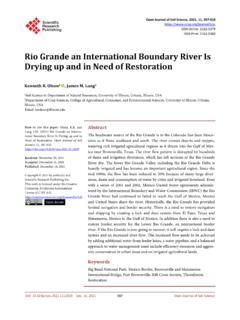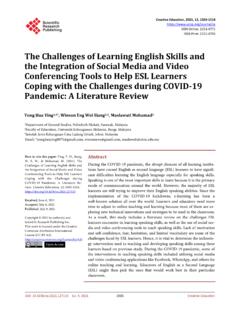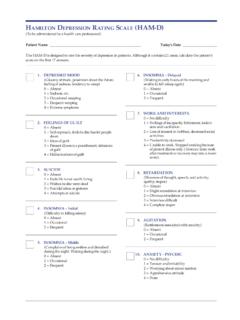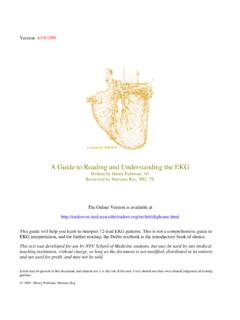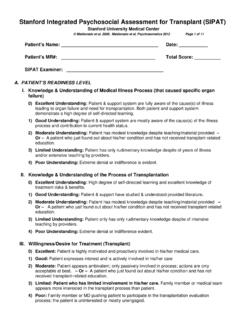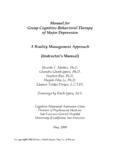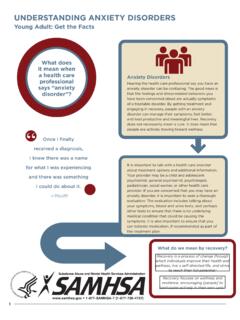Transcription of A Practical and Contemporary Model of Depression for Our ...
1 Open Journal of Depression , 2021, 10, 54-89 ISSN Online: 2169-9674 ISSN Print: 2169-9658 DOI: May 18, 2021 54 Open Journal of Depression A Practical and Contemporary Model of Depression for Our Times A Timeless Existential Clinician s Perspective Sebastian Salicru PTS Psychology, Canberra, Australia Abstract Problem: Depression is spreading rapidly worldwide. It has been forecasted to become the leading cause of disability worldwide by 2030, despite signifi-cant efforts and investments made to treat it. This menace has been exacer-bated by the current COVID-19 pandemic which has triggered psychological distress and a surge in experiences of emptiness, sadness, and loss of meaning in life.
2 Meaninglessness is one of the biggest threats of our times and is asso-ciated with Depression and suicide. Gap: Existential psychotherapy has been neglected by researchers and remains misunderstood by the new generation of clinicians as an integrative approach to the prevention and treatment of Depression , despite being one of the longest-established forms of psychothe-rapy. Objective: To address the above gap, recommendations, and emerging risks. Methodology: Review of theoretical and empirical findings, and au-toethnography taking a scientist-practitioner stance. Results: A comprehen-sive, Practical , integrated, flexible, and evidence-based Model for the preven-tion and treatment of Depression , and other internalizing disorders.
3 Utility: This Model will be of interest to researchers, practitioners, students of psy-chology, and the wider public. Conclusion/Recommendations: The Model can be used to promote preventative factors in youth development, develop protective factors in high-risk populations with vulnerability to Depression , and treat individuals experiencing Depression or other internalizing disord-ers. Keywords Depression , Existential, Humanistic, Experiential Therapies, Psychotherapy Integration, Meaning, Purpose, Authenticity, Freedom, Responsibility How to cite this paper: Salicru, S. (2021). A Practical and Contemporary Model of Depression for Our Times A Timeless Existential Clinician s Perspective.
4 Open Journal of Depression , 10, 54-89. Received: February 28, 2021 Accepted: May 15, 2021 Published: May 18, 2021 Copyright 2021 by author(s) and Scientific Research Publishing Inc. This work is licensed under the Creative Commons Attribution International License (CC BY ). Open AccessS. Salicru DOI: 55 Open Journal of Depression 1. Introduction Depression is affecting over 300 million people worldwide (Zghoul et al., 2019: p. 95). Depressive disorders rise sharply after puberty (Lewinsohn et al., 2000), affecting 1% to 6% of adolescences each year worldwide (Thapar et al., 2010), and are usually associated with the onset of secondary disorders, impairment in social and occupational functioning, substance use disorders, and increase in suicidality (Hetrick et al.)
5 , 2008). In fact, Depression has reached epidemic pro-portions for children, teenagers and adults in modern life (Bulut, 2019). It has become a major public health issue and is projected to become the leading cause of disability worldwide by 2030. (Ebert & Cuijpers, 2018: p. 1). Sadly, despite significant efforts and investments made to treat Depression , mostly using pharmacological and psychosocial interventions, recent epidemio-logical research indicates that the prevalence of Depression has not declined in recent decades (Ormel et al., 2020). This is due to the fact that such efforts have mostly focused on the treatment rather than prevention of Depression , the qual-ity deficiencies in existing treatments, and the overestimation of their effective-ness (McLaughlin, 2011).
6 Improving this precarious state of affairs requires more timely and high-quality interventions, more judicious prescription of an-tidepressants, the consideration of psychological alternatives, offering more psy-chosocial treatment in primary care, and embedding more socially structured interventions (Ormel et al., 2020). The COVID-19 Pandemic, Meaningless, and Existential Approaches Tackling Depression today matters more than ever before because the current situation has been aggravated by the existing COVID-19 pandemic, which is associated with distress, anxiety, fear of contagion, Depression and insomnia in the general population and among healthcare professionals (Sher, 2020: p.)
7 707). Recent meta-analytic research indicates that about one in three adults among the general population had anxiety or Depression since the pandemic started (Luo et al., 2020; Wang et al., 2020). Restrictive life measures and uncertainty about the future is making individuals vulnerable to feelings of helplessness and hopeless-ness, along with the corresponding increased risk of Depression , anxiety, and re-lated suicides worldwide ( Pinto et al., 2020). This recent outbreak has triggered a surge in experiences of emptiness, sad-ness, and loss of meaning in life (De Jong et al., 2020). Meaninglessness relates to a pervasive sense of the absence of purpose, significance and direction, with a tendency to reject meaning and higher-order explanations (Twenge et al.
8 , 2003). Underlying most suicide attempts is a failure to create meaning (Rogers, 2001). Not surprisingly, it has been suggested that suicide rates will rise and are likely to become a greater concern (Gunnell et al., 2020; Reger et al., 2020). This is in line with previous research that identified meaninglessness as one of the biggest threats of our times, and a possible symptom of Depression (Vanhooren, 2019). S. Salicru DOI: 56 Open Journal of Depression Individuals who experience Depression report lower levels of meaning (Volkert et al., 2014) and feelings of meaninglessness are associated with Depression (American Psychiatric Association, 2013). Conversely, people high in meaning in life tend to have better mental health than those low in meaning in life within the context of COVID-19 (Arslan et al.
9 , 2020: p. 1). Therefore, existential ap-proaches have re-emerged and been proposed as critical protective factors and coping strategies to deal with the current global mental health crisis, and as an opportunity for growth (Joseph et al., 2020). Castiglioni and Gaj (2020), for ex-ample, propose the reconstruction of meaning-making processes as the means to normalize current distressing experiences due to the pandemic. In a more gener-al way, Schippers and Ziegler (2019) propose life crafting as a way for individuals to find purpose and meaning in life, improve their adaptive coping, and ability to take control of their lives. Meaning acts as a buffer against the effects of stress on well-being (Mascaro & Rosen, 2006: p.
10 183), and is a strong protective and preventive factor against Depression and suicidal tendencies. Regrettably, today s generation of young clinicians appear unfamiliar with how to incorpo-rate existential concepts when treating adolescents experiencing internalizing symptoms (Shumaker, 2012: p. 375) with other Contemporary validated treat-ments ( CBT, IPT). Adolescence and Young Adult Development In addition to the above, the current context presents unique and increasing challenges for adolescence and young adults in the development of their identity, and finding meaning and purpose in life. How adolescents formulate their iden-tity has a critical impact on the rest of their lives.

